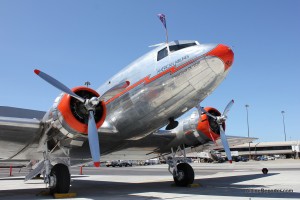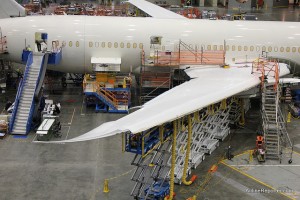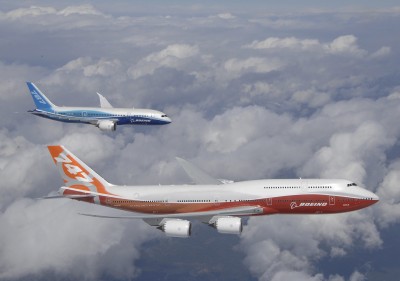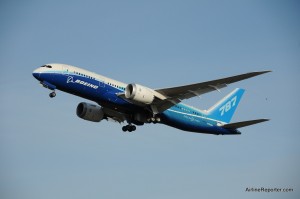
Boeing 787 Dreamliner ZA001 at Paine Field.
What is in a name? Well a lot actually. Could you imagine the Boeing 787 not being called the Dreamliner? Well, it almost happened. The 787 was almost called the Global Cruiser instead.
When the Boeing 787 was first discussed, Boeing named it the 7E7. Randy Tinseth, Vice President , Marketing for Boeing Commercial Planes, describes the naming process on his Randy’s Journal Blog.
Tinseth explains how there were many different naming sessions and workshops to come up with a proper name. After many different sessions and post the trademark and legal teams it seemed that the name Global Cruiser was leading the pack.
Boeing decided to hold a contest to see what the name would be. The finalists were: Dreamliner, Global Cruiser, Stratoclimber, and the eLiner.
Almost 500,000 votes came in from 160 different countries and it was a close race. Counting just votes in the US, the name Global Cruiser would have won. But with all the votes world-wide, the name Dreamliner won by only 2500 votes.
I couldn’t imagine the Dreamliner being named anything else — it fits the aircraft well. Although if Global Cruiser would have won, the DreamLifter probably would have been called the Global Lifter which sounds pretty sweet.
Do you think something would have been lost or gainedwith another name?
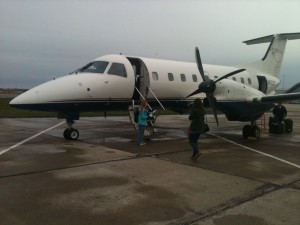
Mauiva's Embraer EMB-120 Brasàlia (N653CT) used to be a private plane, now it is an AirCruise.
A new venture has started that could help revolutionize how people travel: the AirCruise by Mauiva. They are taking the concept of an all inclusive boat cruise and flying passengers to different destinations with-in the US. AirlineReporter.com got an exclusive first-hand look at what this new venture will look like.
With AirCruise, you pay one fee, show up to the airport and enjoy your trip. I was invited to take a test run of their tour, but my schedule wouldn’t allow me to do it. I thought this was such an important concept that I had my father and stepmother take the trip and report back their findings.
Having them go was a good match. Both are well traveled and have high expectations when they travel and would be critical of this new start up. After seeing how things went, I only wish I was able to go. I will be quoting my father to give his first-hand experience through out the story.
Normally, the “All-American East Experience” starts off in New York city, but this being a test flight, the group met up in Orlando, FL. My father and step mom met at the executive airport in Orlando where their Embraer EMB-120 was waiting for them. About 30 guests were invited on this beta trip and they took off towards Niagara Falls.

View of Niagara Falls from the hotel -- not too shabby.
“We departed executive airport via an EMB-120 with 30 Mauvia, Tourico, and invited guests. We landed at Niagara Falls, NY airport where we boarded a land cruiser with a local area expert guide. We were able to View the American Bridal and Horseshoe Falls from above and below before departing for Niagara Falls, ON Canada.”
“The views from the Canada side were panoramic and beautiful. A local attraction, ‘The White River Walk,’ was one of a few level six rapids in North America. The sights and sounds were awe inspiring. After walking along the Niagara river we when to Elements, a restaurant within a rocks throw of the falls where a delicious lunch was served.”
“After an exciting day learning about and observing the falls we were handed keys to our rooms, dropped off at the Hilton’s door and proceeded directly to our rooms were our luggage was waiting.”
They had a very restful night and after breakfast the next morning, boarded a bus and headed to downtown Toronto. “The first stop was St Lawrence market which was very unique by US standards; very much old world. A collection of various vendors of meats, breads, cheeses, produce and uniquely particular to the region hand crafts.”

Hershey's Chocolate World
“Next we visited the CN Tower. The highest free standing structure in the western hemisphere. Most remarkable was the glass floor through which you could look down approximately 1500 feet seemingly standing on thin air. We were lucky to be with the tour group since we had access to the VIP entrance and didn’t have to wait in line.”
“After a short drive through the countryside we arrived at Caroline’s vineyard for Ice Wine tasting. The grapes are harvested only after the grapes have been exposed to temperatures of -8 degrees C for 10-12 hours. The grapes are harvested, pressed and started on the fermenting process which produces a delicious, sweet after dinner drink.”
The third day really showed the advantages of the AirCruise. While crossing the boarder from Canada back to the US, there was a long back up of buses. People were having to wait two and a half hours just to cross. Since AirCruise operated a private plane, it was waiting for them even after their long delay. However, tourists on other coaches weren’t so lucky, since their regularly scheduled flights were not going to wait for them. “The advantages of flying out of Niagara Falls on our private commuter aircraft became clear,” my father explained.
Then it was off to Harrisburg, Pennsylvania to check out all the rich history and unique culture. ” We took a short flight to Harrisburg PA, where the US Vice President’s plane landed in Harrisburg less than two minutes after our landing.”
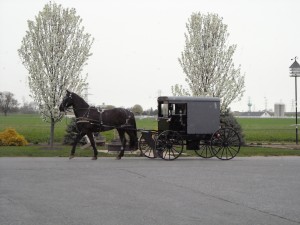
Lancaster County touring the Amish Community
“We loaded aboard the coach and proceeded to Hershey’s Chocolate World in Hershey PA, the chocolate capital of the US. There, we experienced chocolate tasting, made our own personalized candy bar, and saw an attraction ride much like It’s a Small World that showed the making of milk chocolate.”
“We next set off for Amish Country. The Amish are known for simple living, plain dress, and reluctance to adopt many conveniences of the modern technology. We boarded a local Amish tour and visited the nearby Amish farmland before viewing a screening of Jacob’s Choice. We next visited an Amish one room school house and Amish homestead. Wrapping up the day we enjoyed an Amish farm feast dinning experience… a smorgasbord dinner served family style.”
They stayed the night in Lancaster and the next morning, it was time to get back on the plane and take a short flight to Washington DC.
“After landing at The Dulles airport we loaded on a coach and proceeded to the Lincoln, Korean, and Vietnam Memorials. After viewing the memorials we headed to Georgetown, the university district for lunch. There were quite a few unique restaurants along the Potomac river and in the town center. Post lunch we visited Arlington National Cemetery where we saw JFK, Robert, and Ted Kenny’s grave site as well as General Robert E. Lee’s residence.”

The White House is setting up for their Easter Egg hunt.
“A short coach trip later and we were at the White House, where preparations were being made for the White House Easter Egg Hunt. The Capital Building, Washington Monument, and Reflecting Pool were very impressive sights as you looked from one end of the Washington Mall to the other… awesome!”
“On our way to the Washington Hilton, where we were staying for the night, we passed through Washington’s China Town and Embassy Row. The last national landmark we would see before checking into the hotel to relax before dinner was the National Cathedral, a magnificent example of English mid-evil design. Dinner was at Bistro Bistro, Italian cuisine.”
During their final day, they woke up to another great breakfast before heading out on the boat “Spirit of Mount Vernon” to take a tour across the Potomac River.
“The boat tour across the Potomac was exciting as we recalled the adventures of Washington. An escorted tour of Mount Vernon followed, the plantation home of the first President of the United States. Mount Vernon was designated a National Historic Landmark in 1960. A leisurely lunch at Mount Vernon brought memories of simpler days. After lunch we boarded our coach for the return to Dulles airport and our flight back to Orlando.”

Washington Monument via Potomac River
When asked if this is what people should expect on the “real” AirCruise, my father stated, “Everyone is expecting the regularly scheduled AirCruise to go like this one except smoother and some minor tweets to the schedule.”
It seems this new venture could be a huge success. They are taking the concept of the American road trip to the next level. ’œThe Mauiva AirCruise is transforming the American road trip,’ said Lauren Volcheff, Vice President of Marketing, Travel Holdings, Inc. ’œVacationers can finally access some of the world’s most famous sites and still have the time to enjoy their signature qualities. No endless hours on the road. No bad directions. No struggling with luggage or packing up the car. ’
This trip, called the ’œAll-American East Experience,’ entails five nights and six full days with the following destinations:
- Niagara Falls, American and Canadian sides
- Toronto and Niagara On The Lake
- Hershey Chocolate Factory in Hershey, PA
- Amish country in Lancaster, PA
- Washington, D.C.
- Mt. Vernon (George Washington Estate)
Mauiva will also have an AirCruise on the west coast called, ’œWestern Wonder Experience’ which will last six nights and seven full days. Stops include:
- Monterey and Carmel, CA
- San Francisco, CA
- Sausalito, Muir Woods and Sonoma County, CA
- Yosemite National Park
- Las Vegas, NV and the Hoover Dam
- Grand Canyon and Bryce Canyon, NV

Mount Vernon - home of Martha & George Washington
So, the big question is: What does this cost? Surprisingly very little for everything you get. The east coast experience costs $1499.00 and the west coast tour costs $1799.00.
These fees cover almost everything: All attractions, upscale, branded hotels, breakfast and dinner daily, all taxes, fees and gratuities, private airports and flights, luggage delivery to/from hotel rooms, deluxe coaches, guaranteed daily departures, itinerary-inspired souvenirs (i.e., waterproof packs in Niagara Falls and wine openers in Napa Valley), experienced and multi-lingual tour guides and complimentary Daily Mauiva Newsletter detailing the following day’s activities/destinations & weather/recommended dress.
If you had unlimited resources, you could hop on your private jet and have people pre-plan everything and have an experience just like this. For most of us, we do not have that kind of money, but we could get the experience with an AirCruise.
A lot about this adventure is the lack of waiting and hassle. Since the plane takes off at executive airports, there is no TSA to deal with.

Arlington National Cemetery
Once you land, the bus is already sitting at the tarmac waiting for you. Then when you get to your tourist attractions, you do not have to wait in line, you get VIP treatment and are able to do right in. Then when you arrive to your hotel, your bags are already waiting. My father confirmed that this truly is, “a first class tour with no hassles, every need is met without having to worry about it.”
No, I am not getting paid anything to write this blog. Heck, I didn’t even go on the trip. I am helping to promote this concept, since I honestly love the idea. I love to travel, I love to fly and I do not love to worry. This combines them all into one easy-to-use package and I hope this concept spreads.
The first passenger carrying flights for the AirCruise will start on June 1, 2011. Tickets can be reserved via their website.

